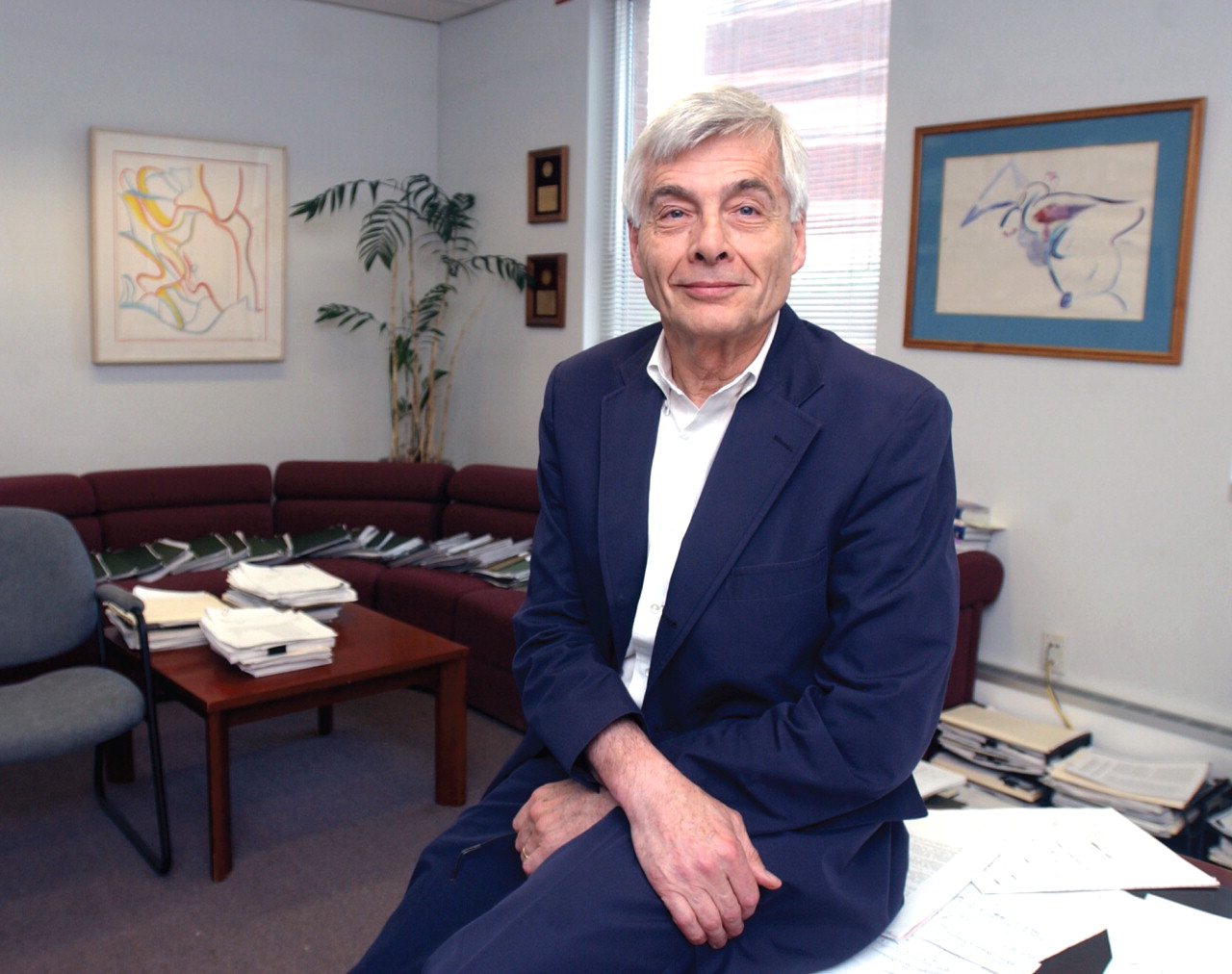Psychiatrist Thomas McGlashan, M.D., recalls participating as a third-year medical student at the University of Pennsylvania in a research project with the late Martin Orne, M.D., who did groundbreaking empirical research in hypnosis and pain management.
Subjects were required to perform a mildly painful task, after which subjective experiences of pain were compared among those who were hypnotized, those given an analgesic medication, and those given a placebo.
“The subjective accounts of pain were utterly compelling,” McGlashan said. “The subjects who were highly hypnotizable did not feel pain at all.”
The experiment confirmed for him the brain's remarkable capacity for imposing its own reality, a phenomenon that had caught his attention a year before when he met his first patient with schizophrenia while on rotation in a psychiatric ward.
“She was a very nice woman who was profoundly paranoid and delusional,” he recalls. “I was amazed and absolutely enthralled at how she could be so intact in many ways and so deteriorated in others.
“Especially fascinating was the conviction she had about her own reality,” he said. “It was the first time I came face to face with the fact that reality doesn't exist out there—reality is created by the brain. And it was my first encounter with the mystery of the brain.”
For the next 40 years, McGlashan would seek to understand the mechanisms behind the brain's creation of aberrant reality in patients with schizophrenia. In time he would put forward a developmental model of brain dysfunction that explained the disease and its varied symptoms and forms (see“
Pruning Key to Schizophrenia Model”).
But his insights into the developmental nature of brain dysfunction in schizophrenia were founded on intensive psychoanalytically oriented observation and treatment of the sickest patients early in his career.
McGlashan's own research on the long-term outcome of psychoanalytically treated, unmedicated patients would challenge that approach; but the strenuous effort to understand the person behind the disease would inform his more recent championing of psychosocial treatments for schizophrenia.
In recent years he has merged the neurodevelopmental approach to brain pathology in schizophrenia with population-based studies in Scandinavia and elsewhere to help forge a new understanding of the “prodromal” phase of the disease.
Ming Tsuang, M.D., distinguished University Professor of Psychiatry and director of the Center for Behavioral Genomics at the University of California, San Diego (UCSD), called McGlashan a “pioneer” on a frontier of schizophrenia research—the effort to apply psychosocial and pharmacotherapeutic treatments to at-risk individuals before the onset of acute psychosis.
“The future treatment of schizophrenia will be focused on early detection of the condition before the onset of psychosis,” Tsuang told Psychiatric News. “Research on how to identify clinical features of the prepsychotic state has become of paramount importance, and in this area Thomas McGlashan has been a leader.”
Tsuang is an investigator at Harvard and UCSD in the North American Prodrome Longitudinal Study (NAPLS), a project initiated by NIMH and that includes McGlashan and Scott Woods, M.D., at Yale University. In addition to Yale, Harvard, and UCSD, the NAPLS project includes Emory University, Hillside Hospital, UCLA, the University of North Carolina, and the University of Toronto.
“Ultimately, we would like to establish reliable diagnostic criteria for inclusion of the prodrome in DSM-V,” Tsuang said. “In this effort, Thomas McGlashan's contribution has been indispensable.”
Putting Painful Experiences in Perspective
Following medical school, McGlashan's interest in psychosis was whetted further during residency at the Massachusetts Mental Health Center.
The center's legendary director Elvin Semrad, M.D., insisted that severely disturbed patients could be engaged in a therapeutic relationship by therapists who were willing to sit with them and see the person behind the disease. McGlashan and fellow residents learned the value of helping patients with the task of—in Semrad's words—“acknowledging, bearing, and putting into perspective one's painful life experiences.”
“Semrad was marvelous with these patients,” McGlashan recalls.“ He talked about how they have problems bearing the strength of their feelings, and he would try to bring patients to that capacity—the capacity to bear their own overwhelming feelings.”
The Vietnam War era draft brought an unexpected change of course for McGlashan, when he received a draft deferment to finish his residency in exchange for a commitment to work in the U.S. Public Health Service at the National Institute of Mental Health's Psychopharmacology Research Branch.
“It would not have been my first choice,” he said. “But I served as executive secretary for the branch and got to meet and spend a lot of time with the nation's experts on psychopharmacology. And I learned a lot about the ins and outs of clinical trials.”
Later, he joined the NIMH intramural program working with William Carpenter, M.D., on a unit Carpenter was running for unmedicated, first-episode schizophrenia patients.
“The idea was to create a highly structured milieu with different things going on every hour during the day,” McGlashan said. “It was a very lively and interesting setting with people for the most part getting better and going into remission without medication.”
In January 1977 Carpenter published an article in the American Journal of Psychiatry, along with McGlashan and John Stauss, M.D., titled“ Treatment of Acute Schizophrenia Without Drugs: An Investigation of Some Current Assumptions.”
The article described a “small but significantly superior outcome” for a cohort of unmedicated patients who received intensive psychosocial treatment, compared with a control group of patients who received“ usual” care including antipsychotic medication.
“We didn't write this paper to suggest it was a preferred treatment, but to alert people to the fact that patients can get better without drugs,” McGlashan told Psychiatric News. “That experience was important to me—it has helped me avoid categorical thinking of the sort that says, 'This is the way it has to happen, and any deviation is malpractice.'”
Analytic Approach Reevaluated
In 1975 McGlashan joined Chestnut Lodge in Rockville, Md., where Frieda Fromm-Reichman, Ph.D., and Harold Searles, M.D., among others, had championed a psychoanalytic approach to treating schizophrenia.
He would stay there 15 years, and the enormous expenditure of attention to individual lives was unforgettable. “There were a lot of aspects that I came to disagree with, but I think the care that people got there was the best I've ever seen,” he said.
But McGlashan now believes that for some patients the rigors of an analytic approach were disorganizing.
“They fill their lives with what is being created in their brain,” he said. “If you rob them of external stimulation by not talking to them about what you think is real, they will fill up the space with delusions and hallucinations and all manner of disorganized thinking.”
In fact, the futility of those efforts in time became impossible to ignore, and McGlashan undertook an extensive research project to follow long-term outcomes of patients treated at the lodge.
The results were dispiriting. In a paper in the June 1984 Archives of General Psychiatry—one of a series of reports on the follow-up study—he reported that of 163 schizophrenia patients followed for an average of 14 years after treatment at the lodge, about two-thirds were functioning marginally or worse.
If a measure of scientific integrity is the capacity to test and disprove one's own fondest hypotheses, the paper is a landmark. And it would help redirect efforts at the lodge.
“The results were not good news for the medical staff or the director, but they were taken seriously,” McGlashan said. “In time things changed, and we began using medications regularly.”
Rehabilitative services, remedial work, and sheltered workshops were initiated. “It was a belated embracement of community psychiatry,” McGlashan recalls. “The staff were initially resistant until they saw that it made a clear difference. Patients didn't get well, but they did get better.”
Treating Patients in the Prodrome
Is there something that survives from the effort to apply a psychodynamic approach to the treatment of schizophrenia?
“Seeing patients as people, not just cases,” McGlashan said.“ Also, I got a sense from knowing the life stories of these people that it was a developmental disorder. And I began to think that if we could intervene earlier, we might be able to lessen the severity and chronicity or even prevent the onset.”
Today McGlashan is conducting population-based, public-health research projects aimed at preventing schizophrenia or diminishing severity and chronicity through early intervention during the“ prodrome”—the subclinical phase recognized as a precursor to acute psychosis.
The success of prevention efforts “is hard to prove,” he said,“ but I think it's well worth thinking about. The work that has been done on the prodrome shows you can identify people at high risk before onset, and a large percentage of these people do become psychotic within two years.”
For the last 10 years, he has been working with colleagues in Scandinavia looking at duration of untreated psychosis in first-episode patients as a possible correlate of chronicity.
In a paper published last year in Schizophrenia Bulletin, they described an extensive public-health effort in one district of Norway to identify and treat first-episode patients aggressively earlier in their psychoses.
First-year follow-up data showed that the public-health effort was effective. “The patients were younger on average by five years [when they were identified and treated] and were less symptomatically ill and better functioning,” McGlashan told Psychiatric News. “Clearly we were getting to people earlier in their illness when it was less severe.”
A handful of treatment studies suggests that treatment during the prodrome can reduce severity of illness or delay onset of psychosis.
For instance, in the May 2006 American Journal of Psychiatry, McGlashan and colleagues reported a randomized trial at four North American clinics in the Prevention Through Risk Identification, Management, and Education project. Outpatients who met criteria for prodromal schizophrenia received olanzapine or placebo during a one-year, double-blind treatment period and no treatment during a one-year follow-up (Psychiatric News, May 5, 2006).
Results showed that 16.1 percent of olanzapine patients compared with 37.9 percent of placebo patients experienced a conversion to psychosis—a trend-level difference that fell just short of statistical significance. McGlashan believes that cognitive-behavioral therapy, cognitive-enhancement therapy, and other psychosocial approaches may also be effective as prodromal treatments.
And so the psychoanalyst-turned-developmental neuroscientist-turned public health researcher has come full circle.
“In many ways my thoughts about the future of schizophrenia treatment are going back to psychosocial forms of intervention, especially at these early phases,” he said. “One of the most important things is to keep these young people engaged and keep them from withdrawing. The earlier you can intervene in the developmental process, the more psychosocial interventions are going to have an impact.”

